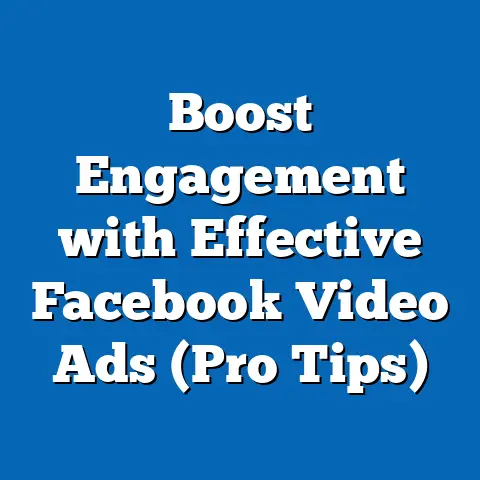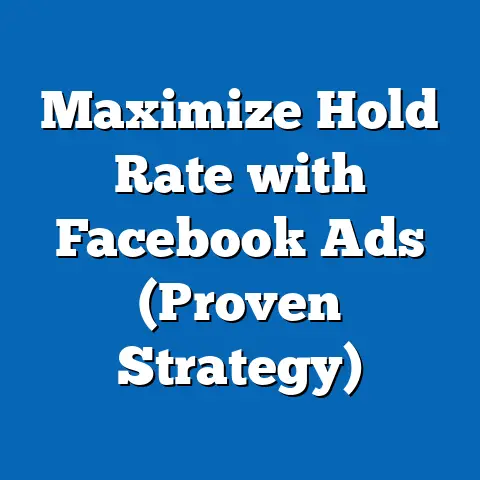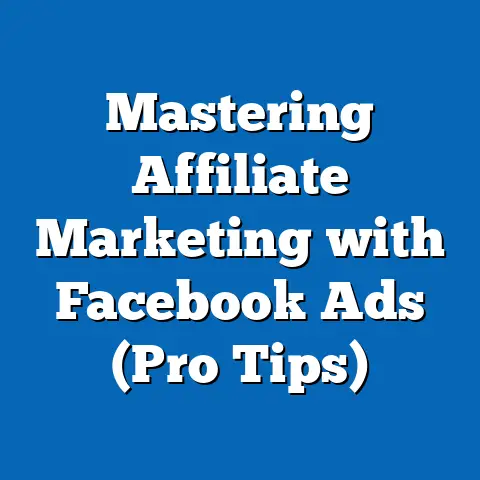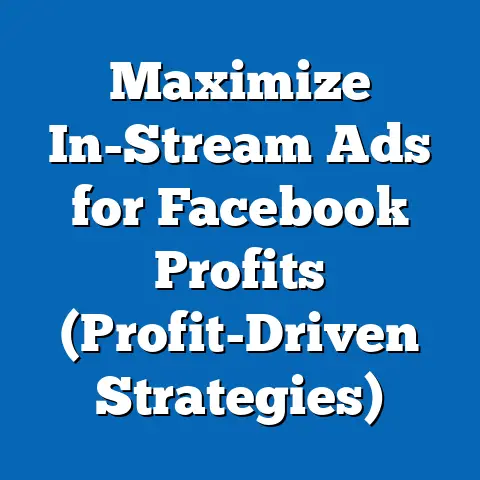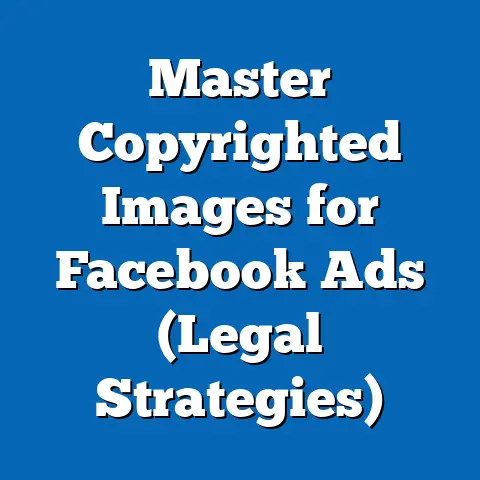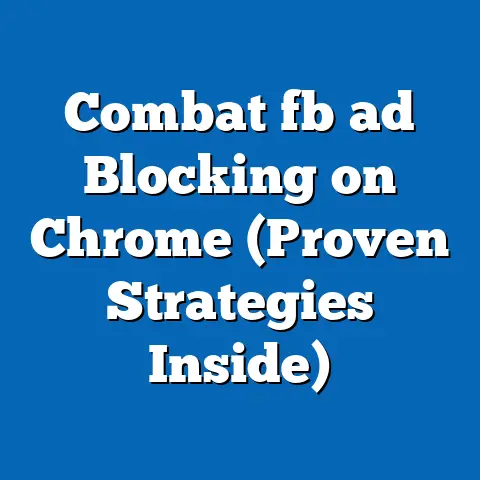Navigating fb ad Boycotts: Strategies for Success (Expert Insight)
It’s funny, isn’t it? How the state of our physical space often mirrors our mental space. I remember a time when my office was so cluttered with papers, half-finished projects, and forgotten coffee mugs that I couldn’t even think straight, let alone be productive. Cleaning it up wasn’t just about tidiness; it was about creating a space where I could focus, strategize, and actually get things done. This feeling is surprisingly similar to managing a Facebook ad campaign when a boycott is brewing. Just as a clean and organized office allows for better productivity, a well-strategized approach can help brands navigate the complexities of ad boycotts on Facebook. The emotional and psychological benefits of a clear environment translate directly into marketing clarity, enabling better decision-making and more effective campaigns.
But what happens when the platform itself feels cluttered with controversy? That’s where Facebook ad boycotts come in. These movements, often driven by social justice concerns or ethical advertising issues, can send ripples through the marketing world, leaving brands scrambling to figure out their next move. In this article, I’ll be your guide through the often murky waters of Facebook ad boycotts, providing a comprehensive overview of what they are, why they happen, the financial implications, and most importantly, the strategies you can use to navigate them successfully. Think of this as your ultimate guide to decluttering your Facebook ad strategy in the face of adversity, leading to a clearer, more focused, and ultimately more successful approach.
Understanding Facebook Ad Boycotts
A Facebook ad boycott is essentially a coordinated effort to pressure Facebook (now Meta) to change its policies or practices by withholding advertising revenue. It’s a powerful tool employed by advocacy groups, consumers, and sometimes even other businesses, to voice their concerns about issues like hate speech, misinformation, data privacy, or other ethical considerations.
Think of it like this: Facebook relies heavily on ad revenue to keep its lights on. When a significant number of advertisers pull their ads, it hits Facebook where it hurts – their bottom line. This financial pressure forces them to take notice and, hopefully, address the underlying issues that sparked the boycott in the first place.
Notable Examples of Facebook Ad Boycotts:
- Stop Hate for Profit (2020): This was arguably the most significant Facebook ad boycott in recent history. Organized by a coalition of civil rights groups, including the NAACP and the Anti-Defamation League, the Stop Hate for Profit campaign urged businesses to pause their Facebook and Instagram advertising in July 2020. The goal was to pressure Facebook to take stronger action against hate speech and misinformation on its platform. Hundreds of companies, including major brands like Unilever, Coca-Cola, and Starbucks, joined the boycott.
- #DeleteFacebook (Ongoing): While not a formal boycott in the same vein as Stop Hate for Profit, the #DeleteFacebook movement has been ongoing since the Cambridge Analytica scandal in 2018. This movement encourages users to delete their Facebook accounts in protest of the company’s data privacy practices. While it hasn’t had the same direct financial impact as a coordinated ad boycott, it has certainly contributed to a negative perception of the platform.
- Boycotts Related to Specific Content: Throughout the years, there have been numerous smaller-scale boycotts targeting Facebook’s handling of specific types of content, such as vaccine misinformation, political advertising, or content that promotes violence. These boycotts are often organized by grassroots movements or advocacy groups focused on specific issues.
Reasons Behind Facebook Ad Boycotts:
- Social Justice Movements: Many boycotts are driven by social justice movements that demand greater accountability from Facebook in addressing issues like racism, sexism, and other forms of discrimination. These movements often argue that Facebook’s algorithms and content moderation policies contribute to the spread of hate speech and misinformation that harms marginalized communities.
- Ethical Advertising Concerns: Some boycotts are motivated by ethical concerns about the types of content that are allowed to be advertised on Facebook. For example, there have been calls to ban political advertising or advertising that promotes harmful products or services.
- Platform Accountability: A common theme underlying many boycotts is the demand for greater transparency and accountability from Facebook. Advertisers and users alike want to know how Facebook’s algorithms work, how content is moderated, and how the company is addressing concerns about harmful content.
Impact of Boycotts on Advertisers and the Facebook Ecosystem:
- Financial Impact on Facebook: Ad boycotts can have a significant financial impact on Facebook, particularly when major brands participate. The Stop Hate for Profit campaign, for example, was estimated to have cost Facebook billions of dollars in lost revenue. While Facebook is a massive company with diverse revenue streams, these boycotts can still put pressure on its financial performance.
- Reputational Damage to Facebook: In addition to the financial impact, ad boycotts can also damage Facebook’s reputation. The negative publicity associated with these movements can erode public trust and make it more difficult for Facebook to attract and retain users and advertisers.
- Impact on Advertisers: For advertisers, participating in a Facebook ad boycott can be a difficult decision. On one hand, they may want to support the cause and align themselves with ethical values. On the other hand, they may be concerned about the potential loss of revenue from pausing their Facebook advertising. It’s a balancing act that requires careful consideration.
- Changes in Facebook Policies and Practices: Ultimately, the goal of a Facebook ad boycott is to bring about change. In some cases, these boycotts have been successful in prompting Facebook to make changes to its policies and practices. For example, in response to the Stop Hate for Profit campaign, Facebook announced several new measures to combat hate speech and misinformation. However, critics argue that these changes often fall short of addressing the root causes of the problems.
Key Takeaways:
- Facebook ad boycotts are a powerful tool for pressuring the platform to address social and ethical concerns.
- These boycotts can have a significant financial and reputational impact on Facebook and advertisers alike.
- Participating in a boycott is a complex decision that requires careful consideration of ethical values and business goals.
Next Steps:
- Stay informed about current and potential Facebook ad boycotts.
- Assess your own company’s values and how they align with the issues being raised in these boycotts.
- Develop a plan for how you will respond to a boycott if one occurs.
The Financial Implications of Boycotts
Let’s face it, for many businesses, Facebook advertising is a lifeline. It’s how they reach their target audience, generate leads, and ultimately, make sales. So, when a Facebook ad boycott hits, the financial implications can be significant. It’s not just about temporarily pausing your ads; it’s about the potential long-term effects on your brand and your bottom line.
Data on Revenue Impacts:
It’s difficult to pinpoint the exact revenue impact of boycotts, as many factors come into play. However, some studies and reports have shed light on the potential consequences:
- Brand Participation vs. Non-Participation: Brands that actively participated in the Stop Hate for Profit boycott saw varying degrees of impact. Some experienced a short-term dip in revenue, while others saw minimal change. However, the longer-term effects on brand perception and customer loyalty are harder to quantify.
- Small Businesses vs. Large Corporations: Small businesses that rely heavily on Facebook advertising are often the most vulnerable during boycotts. They may not have the resources to diversify their advertising channels or weather a significant drop in sales. Large corporations, on the other hand, may have more flexibility to shift their advertising spend to other platforms.
- Industry-Specific Impacts: The impact of a boycott can also vary depending on the industry. For example, brands that target specific demographics or rely on controversial content may be more likely to be affected.
Long-Term Effects on Brand Reputation and Consumer Trust:
Beyond the immediate financial impact, Facebook ad boycotts can also have long-term effects on brand reputation and consumer trust. Here’s how:
- Public Perception: Participating in a boycott can signal to consumers that your brand is committed to ethical values and social responsibility. This can enhance your brand image and attract customers who share those values.
- Consumer Loyalty: Conversely, not participating in a boycott can be seen as a sign that your brand is indifferent to the issues being raised. This can alienate customers and damage your brand reputation.
- Employee Morale: Your employees are also consumers, and they care about the values of the company they work for. Taking a stand on social issues can boost employee morale and attract top talent.
Assessing and Pivoting Advertising Budgets:
So, how can companies assess and pivot their advertising budgets in response to boycott movements? Here are some key steps:
- Risk Assessment: Before a boycott even occurs, it’s important to assess your company’s vulnerability. How reliant are you on Facebook advertising? What is your brand’s stance on the issues being raised in potential boycotts?
- Scenario Planning: Develop different scenarios for how a boycott could impact your business. What would you do if Facebook ad revenue dropped by 20%? 50%?
- Diversification Strategy: Don’t put all your eggs in one basket. Diversify your advertising channels to reduce your reliance on Facebook.
- Budget Allocation: Reallocate your advertising budget to other platforms or marketing channels as needed.
- Performance Monitoring: Closely monitor the performance of your different advertising channels to see where you’re getting the best return on investment.
- Communication Strategy: Develop a clear communication strategy for how you will respond to a boycott. Be transparent with your customers and employees about your values and your decision-making process.
My Experience:
I remember working with a client, a small e-commerce business, during the Stop Hate for Profit boycott. They were heavily reliant on Facebook advertising for their sales. The decision to join the boycott was a tough one. We had to quickly reassess their advertising budget and shift their focus to other platforms like Instagram and Google Ads. It was a challenging period, but ultimately, it forced them to diversify their marketing efforts and become more resilient. They even saw a boost in brand perception as a result of their participation in the boycott.
Key Takeaways:
- Facebook ad boycotts can have significant financial implications for businesses, both in the short term and the long term.
- Assessing your company’s vulnerability and developing a diversification strategy are crucial for mitigating the risks.
- Participating in a boycott can enhance your brand reputation and build consumer trust, but it’s important to communicate your values effectively.
Next Steps:
- Conduct a risk assessment of your company’s vulnerability to Facebook ad boycotts.
- Develop a scenario plan for how you will respond to a boycott if one occurs.
- Diversify your advertising channels to reduce your reliance on Facebook.
Strategic Response Plans
Okay, so you understand what Facebook ad boycotts are and the potential financial implications. Now, let’s get down to brass tacks: what can you actually do about it? This section outlines effective strategies for brands to respond to Facebook ad boycotts, ensuring continued engagement and visibility, even in the face of adversity.
Subsection A: Diversifying Advertising Channels
This is perhaps the most crucial step. As I mentioned earlier, relying solely on Facebook for advertising is like putting all your eggs in one basket. If that basket falls, you’re in trouble. Diversifying your advertising channels spreads the risk and allows you to reach your target audience through multiple avenues.
Here are some alternative platforms to consider:
- Instagram: Owned by Meta, Instagram shares many of the same targeting capabilities as Facebook, but with a more visually focused platform. If your brand relies heavily on visual content, Instagram is a natural fit.
- TikTok: This short-form video platform is incredibly popular with younger audiences. If you’re trying to reach Gen Z or Millennials, TikTok is a must-consider.
- Google Ads: Google Ads offers a wide range of advertising options, including search ads, display ads, and video ads on YouTube. This platform allows you to reach customers who are actively searching for your products or services.
- LinkedIn: If you’re targeting professionals or businesses, LinkedIn is the platform for you. It’s a great place to generate leads and build brand awareness in the B2B space.
- Twitter: Twitter is a real-time platform where users share news, opinions, and engage in conversations. It can be a great place to build brand awareness and engage with your audience directly.
- Pinterest: Pinterest is a visual discovery platform where users find inspiration and ideas. If your brand is visually appealing and targets a specific niche, Pinterest can be a valuable advertising channel.
- Email Marketing: Don’t underestimate the power of email marketing. Building an email list allows you to communicate directly with your customers and promote your products or services.
- Influencer Marketing: Partnering with influencers who have a strong following in your target audience can be a great way to reach new customers and build brand awareness.
- Traditional Advertising: Don’t forget about traditional advertising channels like TV, radio, and print. While they may not be as targeted as digital advertising, they can still be effective for reaching a broad audience.
Pro Tip: When diversifying your advertising channels, it’s important to tailor your message and creative to each platform. What works on Facebook may not work on TikTok, and vice versa.
Subsection B: Messaging and Brand Positioning
During a Facebook ad boycott, your messaging and brand positioning become more important than ever. It’s crucial to be sensitive and thoughtful in your communication, aligning your message with consumer values.
- Acknowledge the Issue: Don’t ignore the boycott. Acknowledge the issue being raised and let your customers know that you’re aware of it.
- Communicate Your Values: Clearly communicate your company’s values and how they align with the issues being raised in the boycott.
- Be Transparent: Be transparent about your decision-making process. Explain why you’re participating in the boycott or why you’re not.
- Avoid Tone-Deaf Messaging: Be careful not to come across as tone-deaf or insensitive. Avoid using humor or making light of the situation.
- Focus on Solutions: Instead of just complaining about the problem, focus on solutions. What can your company do to help address the issue?
- Be Authentic: Be authentic in your communication. Don’t try to be something you’re not.
Examples of Brands That Successfully Realigned Their Messaging:
- Ben & Jerry’s: Ben & Jerry’s has a long history of taking a stand on social issues. During the Stop Hate for Profit boycott, they publicly supported the campaign and used their platform to advocate for change. This strengthened their brand image and resonated with their customers.
- REI: REI has also been vocal about their commitment to social and environmental responsibility. They paused their Facebook advertising during the boycott and used their platform to promote outdoor recreation and conservation. This aligned with their brand values and appealed to their target audience.
Subsection C: Engaging with the Community
Engaging directly with your audience is crucial during a Facebook ad boycott. It’s a way to show your customers that you care about their concerns and that you’re listening to what they have to say.
- Social Listening: Monitor social media channels for mentions of your brand and the boycott. Pay attention to what people are saying and respond to their concerns.
- Surveys: Conduct surveys to gauge your customers’ opinions on the boycott and the issues being raised.
- Community Outreach: Partner with community organizations to support causes that align with your brand values.
- Live Q&A Sessions: Host live Q&A sessions on social media to answer your customers’ questions about the boycott and your company’s response.
- Create Content That Addresses the Issue: Create blog posts, videos, or social media posts that address the issue being raised in the boycott and explain your company’s position.
Benefits of Transparency:
- Diversifying your advertising channels is crucial for mitigating the risks of a Facebook ad boycott.
- Messaging and brand positioning become more important than ever during a boycott.
- Engaging directly with your audience is a way to show your customers that you care about their concerns.
Next Steps:
- Develop a diversification strategy for your advertising channels.
- Review your messaging and brand positioning to ensure that it aligns with consumer values.
- Implement a social listening strategy to monitor mentions of your brand and the boycott.
Case Studies of Successful Navigations
Now, let’s dive into some real-world examples. Examining how other brands have successfully navigated Facebook ad boycotts can provide valuable insights and inspiration for your own strategies. I’ve chosen a few case studies across different industries to illustrate a range of approaches.
Case Study 1: The Body Shop
- Industry: Outdoor Apparel and Gear
- Initial Challenges: Patagonia, a brand known for its environmental activism, was already critical of Facebook’s policies on climate change misinformation. The Stop Hate for Profit boycott presented them with an opportunity to further their stance.
- Strategies Employed:
- Extended Boycott: Patagonia went beyond the initial one-month boycott, extending their pause on Facebook and Instagram advertising indefinitely.
- Advocacy: They used their platform to advocate for stronger regulations on social media platforms to combat misinformation and hate speech.
- Content Marketing: They focused on creating high-quality content about environmental conservation and outdoor recreation, driving traffic to their website through organic search and social media.
- Email Marketing: They ramped up their email marketing efforts, communicating directly with their customers about their environmental initiatives.
- Outcomes Achieved:
- Reinforced Brand Identity: Their extended boycott reinforced their commitment to environmental activism and resonated with their target audience.
- Increased Website Traffic: Their content marketing efforts drove significant traffic to their website, generating leads and sales.
- Strengthened Customer Relationships: Their email marketing campaigns fostered stronger relationships with their customers, leading to increased loyalty.
- Lessons Learned: Patagonia’s example demonstrates the power of taking a bold stance. By extending the boycott and advocating for change, they solidified their brand identity and attracted customers who share their values.
- Extended Boycott: Patagonia went beyond the initial one-month boycott, extending their pause on Facebook and Instagram advertising indefinitely.
- Advocacy: They used their platform to advocate for stronger regulations on social media platforms to combat misinformation and hate speech.
- Content Marketing: They focused on creating high-quality content about environmental conservation and outdoor recreation, driving traffic to their website through organic search and social media.
- Email Marketing: They ramped up their email marketing efforts, communicating directly with their customers about their environmental initiatives.
- Reinforced Brand Identity: Their extended boycott reinforced their commitment to environmental activism and resonated with their target audience.
- Increased Website Traffic: Their content marketing efforts drove significant traffic to their website, generating leads and sales.
- Strengthened Customer Relationships: Their email marketing campaigns fostered stronger relationships with their customers, leading to increased loyalty.
Case Study 3: A Small Business – Local Coffee Shop
What can we learn from these successes? Here are some key takeaways:
- Align with Your Values: The most successful brands are those that align their actions with their values. If your brand is committed to social justice or environmental responsibility, don’t be afraid to take a stand.
- Diversify Your Advertising: Don’t rely solely on Facebook for advertising. Diversify your channels to reduce your risk and reach a wider audience.
- Engage with Your Community: Engage directly with your customers and listen to their concerns.
- Be Transparent: Be transparent about your decision-making process and communicate your values clearly.
- Focus on Solutions: Instead of just complaining about the problem, focus on solutions.
Key Takeaways:
- Successful navigation of Facebook ad boycotts requires a strategic approach that aligns with your brand values.
- Diversifying advertising channels, engaging with the community, and being transparent are crucial for maintaining visibility and customer loyalty.
- Learning from the experiences of other brands can provide valuable insights and inspiration.
Next Steps:
- Analyze your own brand values and identify potential areas of alignment with social or environmental causes.
- Develop a plan for diversifying your advertising channels.
- Implement a community engagement strategy to connect with your customers on a deeper level.
Future of Facebook Advertising Post-Boycott
So, what does the future hold for Facebook advertising in light of ongoing and potential future boycotts? It’s a question that’s on the minds of marketers everywhere. The landscape is constantly evolving, and it’s important to stay ahead of the curve.
Emerging Trends:
- Increased Regulation: Governments around the world are starting to take a closer look at social media platforms and their impact on society. We can expect to see increased regulation in areas like data privacy, content moderation, and political advertising.
- Changes in Consumer Behavior: Consumers are becoming more aware of the issues surrounding social media and are starting to demand more accountability from platforms. They’re also becoming more discerning about the brands they support, favoring those that align with their values.
- Evolving Landscape of Social Media Advertising: The social media landscape is constantly changing, with new platforms and formats emerging all the time. Marketers need to be agile and adapt their strategies to stay relevant.
- Rise of Alternative Platforms: As concerns about Facebook and other major social media platforms grow, we’re seeing a rise in alternative platforms that prioritize privacy, ethical content moderation, and community building.
Potential for Facebook to Adapt:
Will Facebook adapt its policies and practices in response to advertiser concerns and societal pressures? It’s a complex question. On one hand, Facebook has a vested interest in maintaining its advertising revenue and attracting advertisers back to the platform. On the other hand, the company has often been slow to respond to criticism and has faced accusations of prioritizing profits over ethical considerations.
However, there are some signs that Facebook is starting to take these concerns more seriously. The company has invested heavily in content moderation technology and has announced new policies to combat hate speech and misinformation. It’s also working to improve its transparency and accountability.
Remaining Agile and Responsive:
Ultimately, the key to success in the future of Facebook advertising is to remain agile and responsive to change. Marketers need to be prepared to adapt their strategies as the platform evolves and as consumer behavior shifts. This means:
- Staying Informed: Stay up-to-date on the latest news and trends in social media advertising.
- Experimenting: Don’t be afraid to experiment with new platforms and formats.
- Monitoring Performance: Closely monitor the performance of your campaigns and adjust your strategies as needed.
- Being Flexible: Be flexible and willing to change your plans if necessary.
- Prioritizing Ethical Considerations: Make ethical considerations a priority in your advertising strategies.
Key Takeaways:
- The future of Facebook advertising is uncertain, but we can expect to see increased regulation, changes in consumer behavior, and the rise of alternative platforms.
- Facebook has the potential to adapt its policies and practices in response to advertiser concerns and societal pressures.
- Remaining agile and responsive is crucial for maintaining successful advertising strategies.
Next Steps:
- Stay informed about the latest news and trends in social media advertising.
- Experiment with new platforms and formats.
- Monitor the performance of your campaigns closely.
- Make ethical considerations a priority in your advertising strategies.
Conclusion
Navigating Facebook ad boycotts is undoubtedly a complex and challenging task. The decision to participate, the strategies to employ, and the potential outcomes all require careful consideration and a deep understanding of the landscape. However, it’s important to remember that these boycotts also present opportunities. They force brands to re-evaluate their values, refine their messaging, and diversify their advertising channels.
Just like decluttering a physical space can lead to greater clarity and focus, navigating a Facebook ad boycott can lead to a more resilient and effective advertising approach. By embracing these challenges and adapting to the changing landscape, brands can emerge stronger and more aligned with their values.
So, as you embark on your journey through the world of Facebook advertising, remember to stay informed, be agile, and prioritize ethical considerations. View challenges not as roadblocks, but as pathways to growth and innovation. By doing so, you can build a more resilient and successful advertising strategy that resonates with your audience and contributes to a more just and equitable world.
Key Takeaways:
- Facebook ad boycotts pose significant challenges, but also offer opportunities for brands to refine their strategies.
- Adaptability and innovation are crucial for success in the ever-evolving landscape of marketing.
- By embracing challenges, brands can build a more resilient advertising approach and contribute to a more just world.
Next Steps:
- Continue to stay informed about the latest news and trends in social media advertising.
- Embrace challenges as opportunities for growth and innovation.
- Use your platform to advocate for positive change.

